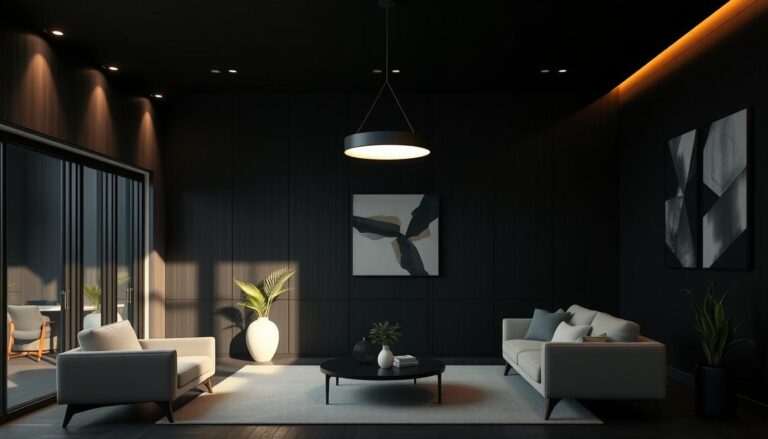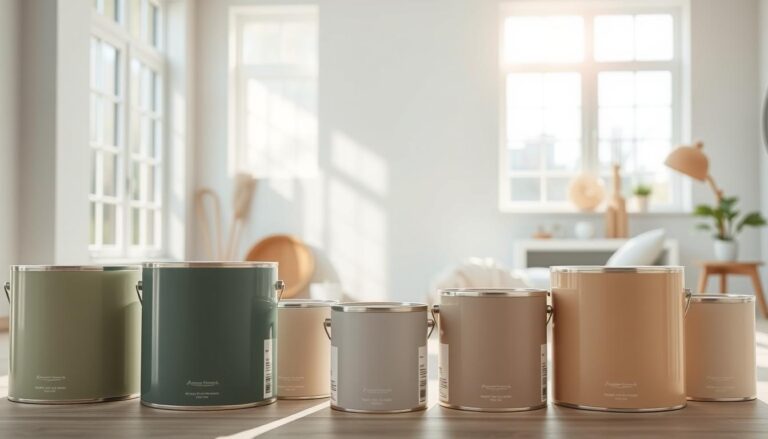Imagine a home where every item has a purpose or brings joy. William Morris once said, “Have nothing in your houses that you do not know to be useful or believe to be beautiful.” Yet, many of us struggle with clutter. Our homes might have junk drawers, closets full of clothes we never wear, or sentimental items that take up too much space.
Creating a clutter-free home begins with making small, thoughtful choices. This guide will show you how to turn chaos into a peaceful, organized living space. It will help you live more simply and support your daily life.
Before you buy something new, ask yourself a few questions. Is it really needed? Where will it go? How will it make my life simpler, not more complicated? These questions can help you avoid buying things you don’t need.
From overflowing bookshelves to family members’ items taking over, there are solutions. The aim isn’t to be perfect—it’s to make progress. Every step toward simplicity reduces stress and makes room for what truly matters.
Key Takeaways
- Declutter by keeping only useful or beautiful items, as Morris advised.
- Common trouble spots include junk drawers, unused clothes, and outdated decor.
- Use “Stop Clutter” strategies like mail sorting systems and daily dish routines.
- Laundry solutions include products like HomeHacks baskets or Etna hampers.
- A daily “Room Reset” routine maintains order without overwhelming effort.
Why Most Homes Struggle with Clutter
Clutter forms because of habits and emotions. The clutter-free lifestyle seems hard to achieve for many. This is because it involves changing deep patterns we often overlook.
Psychology Behind Accumulation
Our emotional ties to objects are strong. A childhood toy or a gift from a loved one feels like a part of us. Research shows 70% of homes keep items because of nostalgia, not need.
Decision fatigue also plays a role. Constantly deciding what to keep is mentally exhausting. Tips like “sort in 15-minute bursts” help make progress easier.
Common Clutter Triggers in Modern Life
- Life transitions (moving, marriage, kids) create instant clutter spikes
- Delayed decisions pile up—like “I’ll deal with this later” turning into endless to-do lists
- Storage solutions often backfire: extra shelves just hide what we already own
How Consumerism Feeds the Clutter Cycle
Ads promote the idea that “more is better.” This leads to buying seasonal items, “limited editions,” and gadgets. The average American home buys 2.5 new items weekly, but only 1 in 5 people regularly donate or recycle old stuff.
This imbalance creates endless clutter. Retail tricks like BOGO deals and “buy one get storage free” make it worse.
“Clutter isn’t just physical—it’s a symptom of habits we’ve learned to ignore.”
Recognizing these patterns is the first step. Knowing how emotions, life changes, and marketing strategies overwhelm us empowers us. Small mindset shifts can turn the struggle into a journey toward a calmer, intentional home.
The Life-Changing Benefits of a Clutter-Free Home
Imagine coming home to a space that invites relaxation instead of stress. A clutter free home is more than looks—it’s a change maker. Studies show that clean spaces improve your mind and mood. Let’s explore how living simply can change your day-to-day:
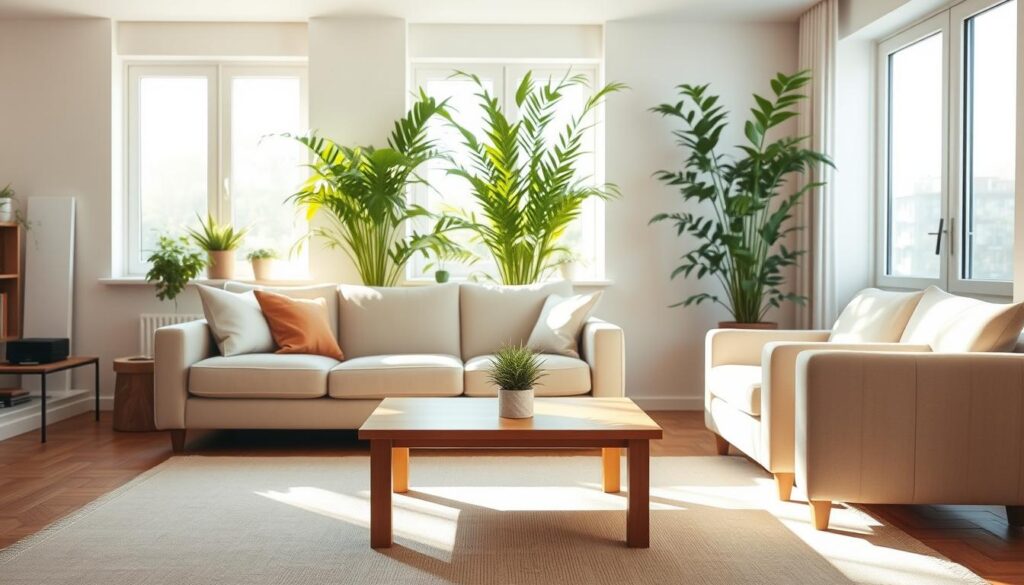
“Clutter competes for attention visually and cognitively,” says a Princeton University study, noting that clutter drains brainpower needed for focus.
- Mental clarity: Less visual chaos reduces anxiety and improves decision-making.
- Time saved: No more wasting minutes searching for keys, bills, or “lost” items.
- Health perks: Decluttered bedrooms lead to better sleep, while tidy kitchens cut stress-induced overeating.
- Financial boost: Buying less and selling unused items can free up funds for priorities.
Take Sarah, who cut her wardrobe in half. She now dresses in 10 minutes instead of 30, and her “junk drawer” donations funded her family’s weekend getaway. Minimalist living also teaches mindfulness—every item you keep serves a purpose, fostering gratitude for what you truly need.
Think of it as space for life’s joy: an empty counter for morning coffee, a clear closet for outfit confidence, or a desk ready for creative ideas. The shift starts small but grows into a ripple of calm and intentionality.
The Minimalist Mindset: Changing How You Think About Stuff
Minimalist living is more than just cleaning up. It’s about seeing your belongings in a new light. Imagine your home as a place where every item has a purpose or brings happiness. This way of thinking helps you stop collecting too much stuff and keeps your home organized.
Joshua Becker says, “Minimalism is about intentionally promoting what you value and removing distractions.”
“Your ‘stuff’ will almost always expand to fill the space available.”
Adopting a “Less is More” Philosophy
Ask yourself: Does this item add value to my life? Or does it just take up space? A minimalist believes in quality over quantity. Instead of having 20 shirts, pick 5 that you can wear often.
Instead of filling shelves, leave some space for calm. This way, your belongings match your goals, like saving money or feeling less stressed.
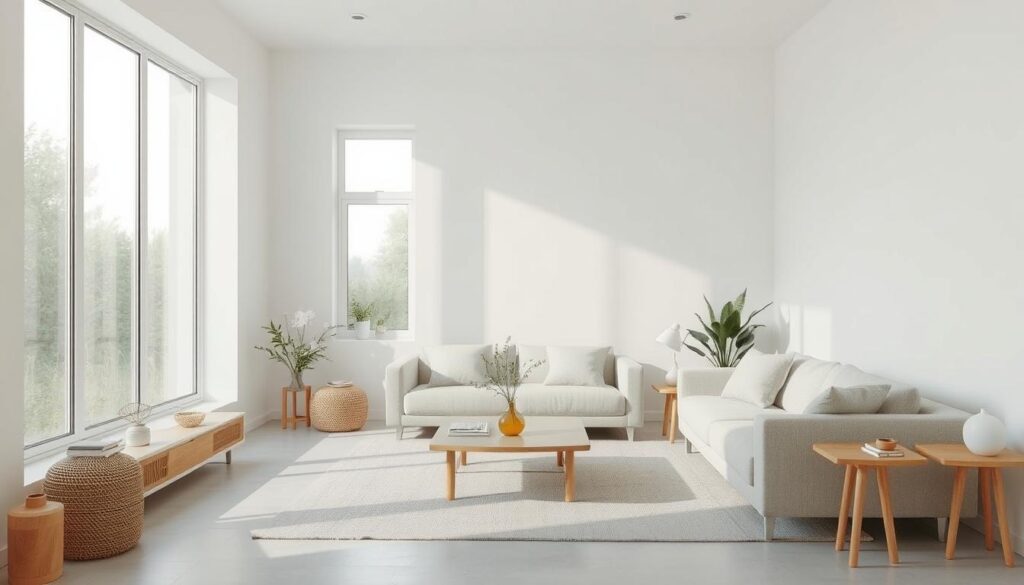
Practical Minimalism for American Households
- Start small: Clean out one drawer at a time.
- Keep only what you use daily or brings joy—no “someday” items.
- Adjust to family needs: Use labeled bins for kids’ toys, not empty rooms.
One family cut their belongings by 50% by following a “one in, one out” rule. They saved space and money, cutting their monthly spending by 20%.
Finding Your Decluttering Motivation
Think about what a clutter-free home means to you. Maybe it means more time for hobbies, less stress, or a smaller environmental impact. Finding these reasons helps keep you motivated.
A 2023 study found that 68% of Americans who went minimalist felt clearer mentally and made fewer decisions.
Remember, minimalist living isn’t about being perfect. It’s about making room for what truly matters—your values, relationships, and peace of mind.
Getting Started: The 15-Minute Decluttering Method
Turn clutter into order with a simple plan. Just 15 minutes a day can make a big difference. Begin with a kitchen counter, a junk drawer, or a mail pile. Use a timer to boost your pace. “Start small and see quick results,” advises Jacky, who keeps her home tidy with daily efforts.
“After getting started, I knew things were going to take time. They ended up taking a lot of time. I was even discouraged at times.” – Jacky’s journey
Essential Tools for Quick Decluttering Sessions
- Labeled bins: Keep “donate,” “trash,” and “maybe” containers nearby
- Trash bags for easy disposal
- Portable storage boxes for categorizing items
Creating a Sustainable Decluttering Schedule
Match tools with routines. Here’s how to make it work:
| Lifestyle | Daily Routine | Weekly Goal |
|---|---|---|
| Busy Professional | 15 minutes after dinner | Declutter one category/week (e.g., books, shoes) |
| Stay-at-Home Parent | 10 minutes during TV commercials | Complete one room’s quick wins/month |
The One-Touch Rule for Daily Tidiness
Deal with items once. Mail? Sort it right away. Dirty dishes? Clean them up immediately. This home organization rule prevents clutter from growing.
Take before/after photos to track your progress. Share them online or in a gallery. Reward yourself weekly with a treat or a quick room check. Every small step leads to big changes.
Room-by-Room Strategies for a Clutter-Free Home
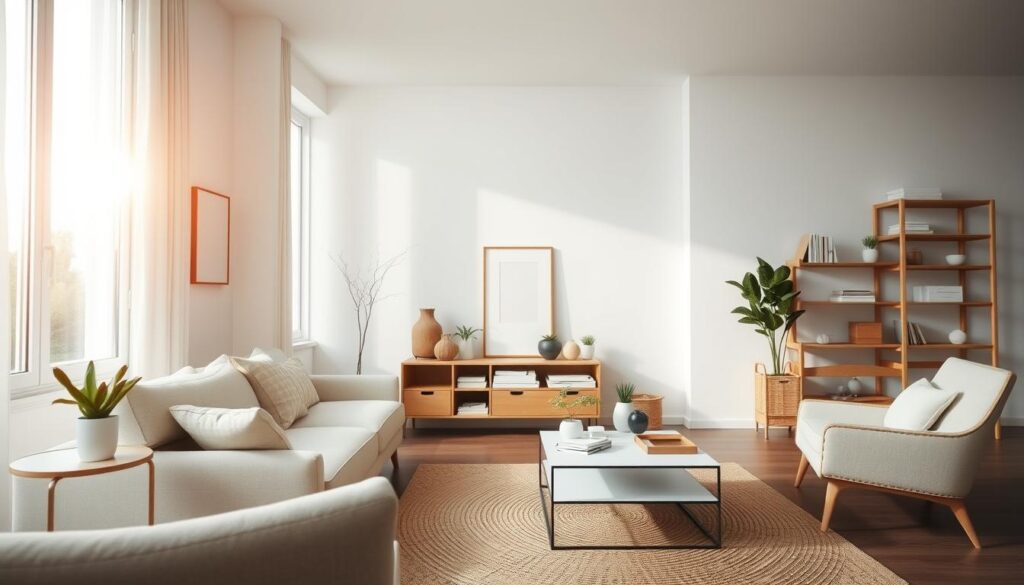
Every room has its own clutter triggers. Start by identifying where mess builds first. “Take a look around your room. Are all the tables covered with unnecessary stuff?” Clear one surface daily to reduce overwhelm.
| Room | Hotspot | Solution |
|---|---|---|
| Kitchen | Crowded counters | Store rarely used appliances in upper cabinets |
| Bathroom | Overstuffed cabinets | Discard expired products; place items at eye level |
| Living Room | Electronics tangles | Use tech trays and cable channels to corral wires |
| Bedroom | Scattered items | Assign a 5-minute nightly routine to return items to their place |
Create a plan focusing on high-impact zones first. Bathrooms need vertical storage for towels. Bedrooms benefit from acrylic letter files for accessories. The organized living space starts with small wins—like tackling one drawer daily. Use waterproof bins in garages to prevent mildew. Remember: consistency matters more than perfection.
- Assign a “donation box” in entryways for items to be sorted weekly
- Use divided drawer inserts to keep kitchen clutter-free home
- Teach kids to fold vertically in closets for easy access
Every space deserves tailored solutions. Prioritize hotspots like entryway consoles or bathroom counters first. Small steps today build lasting habits tomorrow.
Kitchen Organization: From Countertops to Cabinets
Turn your kitchen into a space that works for you with these home organization tips. A messy kitchen can mess up your meal prep and daily life. Start small and focus on areas where you spend most of your time. These decluttering tips make even the tightest spots organized.
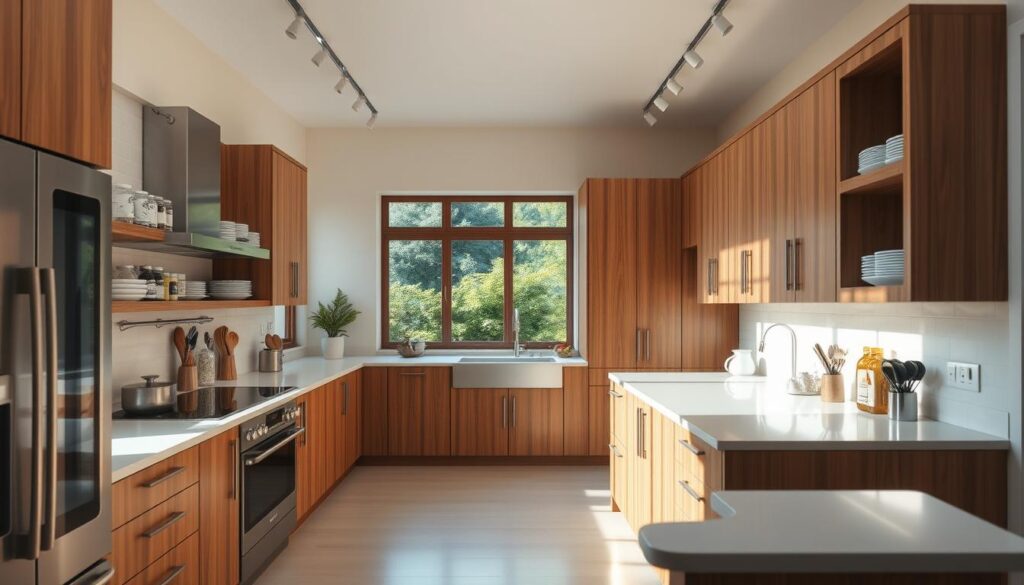
When your sink is full of dishes, your whole kitchen feels messy. Clean dishes and the sink every day to keep things tidy.
Maximizing Small Kitchen Spaces
- Hang pots and pans from a pot rack to save cabinet space.
- Install a pegboard under the cabinets for easy access to utensils.
- Add vertical shelves near work areas for spices and cookbooks.
- Use under-sink baskets for cleaning supplies.
Smart Storage Solutions for Cookware and Appliances
Keep essentials in sight without clutter:
- Drawer inserts organize utensils and gadgets.
- Appliance garages hide blenders and toasters but keep them easy to reach.
- Clear containers in cabinets let you see what’s inside.
- Hang towels and aprons on wall hooks.
Food Storage Systems That Prevent Waste
Rotate groceries with these tips:
- Designate zones for cooking, prep, and appliances on counters.
- Use bins for snacks, baking supplies, and spices.
- Label containers with dates to track expiration.
Conquering Closet Chaos: Wardrobe Organization Made Simple
Turn your closet into an organized living space with easy steps. Begin by checking your clothes—get rid of items you haven’t worn in a year. Donate or sell them to help keep your space clutter-free. Remember, 80% of your outfits come from just 20% of your clothes.
Free up room by switching out seasonal clothes and storing the rest in labeled bins. This way, you can easily find what you need.
“Start by decluttering your bedroom and decluttering your closet. This space sets the tone for how you maintain your home.”
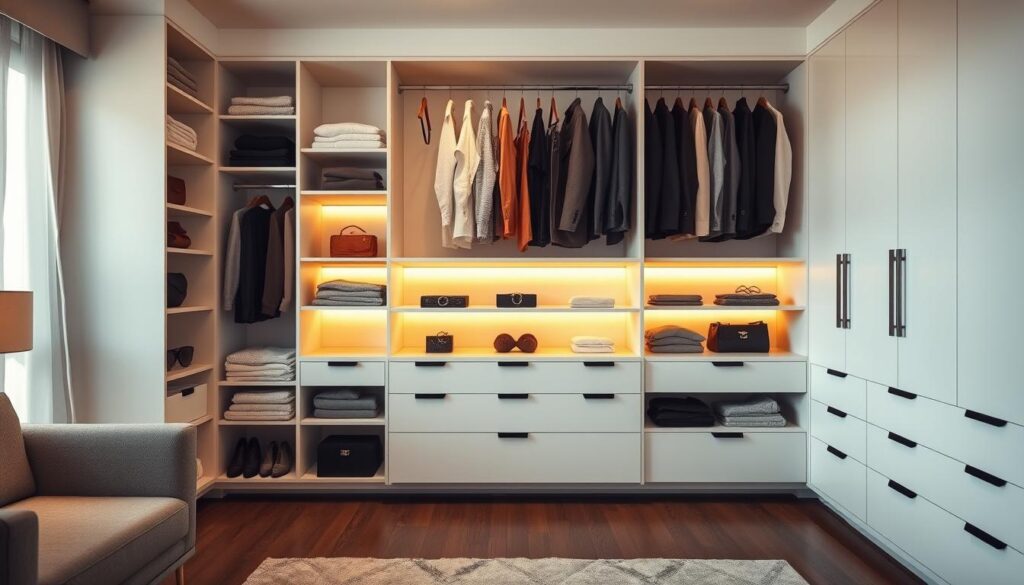
- Maximize vertical space: Install floating shelves or over-door organizers for small closets.
- Customize storage: Brands like The Container Store offer drawer dividers, while California Closets design bespoke systems for walk-ins.
- Smart folding: Use the KonMari method for wrinkle-free storage and clear hangers to color-code categories.
Use eco-friendly items like bamboo drawer liners or recycled bins for accessories. Hang a “donate” bag for things you might not need later. Check it every week. An organized closet is more than just space—it’s a daily reminder of your goals.
When everything has its place, mornings are easier and choices clearer. Your wardrobe can be both useful and unique. Even small changes can lead to lasting order.
Digital Decluttering: Managing the Invisible Clutter
Clutter isn’t just about stuff on your shelves. Digital mess, like a crowded inbox, affects 62% of Americans. It causes stress and anxiety. Cleaning up your digital space boosts your productivity and mental clarity. It’s a crucial part of home organization today.

Email Management Strategies
Begin by organizing your inbox. Here are some decluttering tips:
- Unsubscribe from unwanted newsletters with tools like Unroll.me
- Make folders for “Action,” “Archive,” and “Trash”
- Set aside 10 minutes each day to check emails, not leave them open
Organizing Digital Photos and Documents
Most clutter comes from unsorted files. Try these:
- Use apps like Lightroom to delete duplicate photos
- Save important images on Google Photos or iCloud with clear names (e.g., “2023_SpringTrip”)
- Free up device space with cloud backups while keeping data safe
Creating Digital Systems That Work
Build routines for lasting order:
- Automate bill payments and reminders with apps like Mint or Google Calendar
- Do quarterly clean-ups to get rid of old files
- Use Quantum Fiber Internet for easy cloud access during backups
Small steps can make your screens calm, not chaotic. A tidy digital life is like a tidy home. It’s where technology helps you, not the other way around.
Kid-Friendly Organization: Managing Toys and School Supplies
Creating a clutter-free home with kids means adapting storage to their growth and curiosity. Let’s tackle toy chaos without turning your home into a warzone.
“You cannot walk through your home with a garbage bag and start throwing things away. There will be anarchy.”

Start with age-appropriate storage that grows with your child. Here’s what works:
| Age Group | Solutions |
|---|---|
| Toddlers | Low, open shelves with clear bins labeled with images |
| Preschoolers | Transparent bins with chalkboard labels for naming contents |
| School-Age | Desk organizers for school supplies and labeled cubbies |
| Teens | Customizable wall shelves and under-bed storage for hobbies |
Teach kids to maintain their spaces through routines:
- 15-minute daily tidy-up time with a timer
- Color-coded bins for “keep, donate, trash”
- Game-like cleanup songs or challenges
Rotation systems keep things fresh without overwhelming:
- Store 2/3 toys in a “toy library” closet
- Swap out selections every 2 weeks
- Use clear bins labeled “this week’s picks”
A clutter-free home starts with systems that grow with your family. Mix creativity with consistency, and watch your organized living space thrive.
Minimalist Home Decor That Fights Clutter
“Give your closets, drawers and rooms some breathing room. Donate, toss, or store even a third of the items from a closet or half the accessories from a room and you’ll be amazed by how much tidier it feels!”
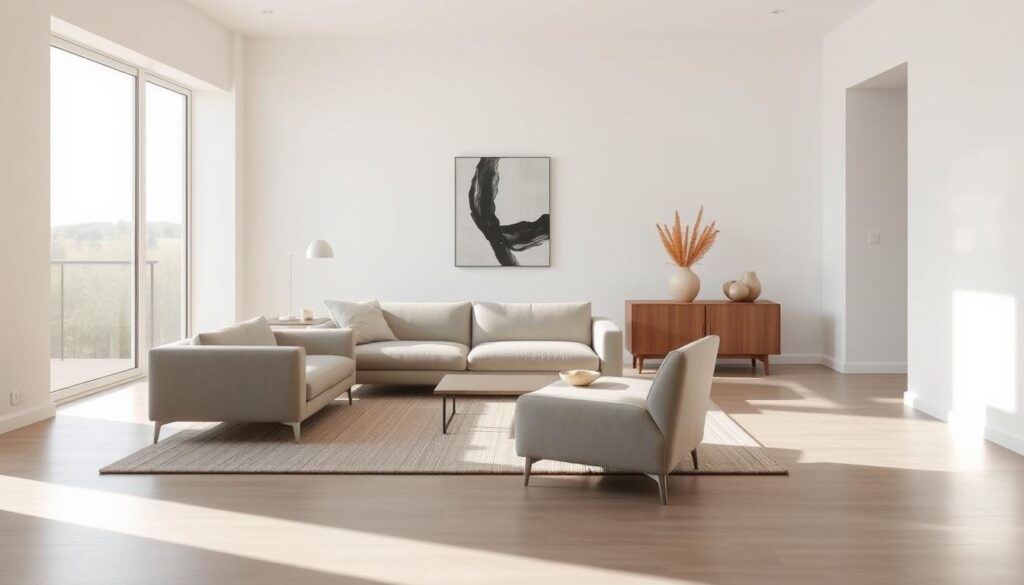
Minimalist home decor makes spaces feel bigger and more peaceful. It uses open layouts and clean lines to let light in. This way, every item in your home has a special place and purpose.
- Paint walls in neutral tones like ivory or soft gray to create a calming backdrop.
- Highlight one bold piece—a sculptural vase or a woven basket—to anchor the room without overcrowding.
- Choose furniture with built-in storage, like a coffee table with a hidden compartment or a bench with shelves.
- Showcase flaws through Wabi-Sabi principles: display a weathered ceramic bowl or a slightly cracked plate as unique statement pieces.
Functional decor saves space. A floating shelf holds essentials while keeping floors clear. A single potted plant adds life without excess. Items that serve multiple purposes keep surfaces tidy.
“Look at your all your surfaces: your kitchen counters, your bookshelves, your bedside tables. Could you improve the space by decluttering just one thing?”
Minimalist living is all about making smart choices. Before buying decor, think if it adds beauty or utility. Keep a donation box out to stay on track. Neutral colors with meaningful items make spaces stylish and calm.
Maintaining Your Clutter-Free Home: Daily Habits That Work
Starting a clutter-free lifestyle is all about small daily steps. These habits prevent mess from building up, making it easy to keep your home organized. Soon, keeping things tidy becomes second nature.
“My husband taught me this tip when our kids were small. If there’s stuff on the floors or in corners, your house feels cluttered. Daily picks-up make all the difference.”
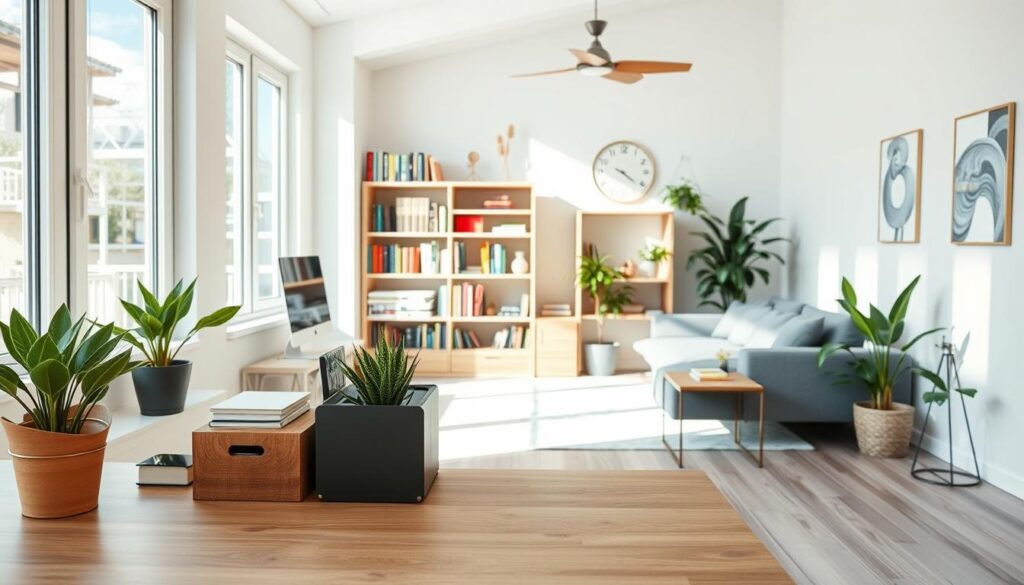
- One-Touch Rule: Deal with mail, keys, or clothes right away. File bills, recycle junk, and put items away immediately. Tools like Paper Karma auto-filter digital mail.
- End-of-Day Reset: Spend 5 minutes nightly putting things back in their place. A tidy evening leads to a clear morning.
- One In, One Out: Give away an old item before buying something new. This stops your closets and shelves from getting too full.
- Quick Daily Tasks: Clean countertops, sort mail, and make beds daily. These quick tasks keep your home tidy.
- Designate Zones: Use bins for keys, mail, and shoes. A “donation basket” by the door makes getting rid of things easy.
Small habits lead to big changes. A good home organization system works when these routines become automatic. For example, putting dishes in the dishwasher after meals or using hooks for coats. These actions help keep your home clutter-free, saving you time and reducing stress.
Conclusion: Your Path to Peaceful, Organized Living
A clutter-free home is within reach. This guide shows how small steps lead to big changes. Start with one drawer or a 15-minute daily routine. Every effort brings you closer to spaces that reflect your values.
Studies show clutter takes focus and increases stress. But a tidy home lowers stress. These findings make the effort worthwhile.
Minimalist living is about intention, not perfection. Letting go of unused items frees up mental and physical space. Try putting things away as you go and donating unused items after six months.
Involve kids in cleaning tasks to build lasting habits. A quick daily wipe-down prevents messes from building up.
Start today with a small action. Clear a counter, sort a shelf, or set a 15-minute declutter timer. Each step builds momentum. Remember, a clutter-free home is a practice, not a one-time task.
Celebrate small victories, like finding keys instantly or enjoying a clean room. Imagine the time and peace you’ll gain. Your home can be a place of rest, not resistance.
Choose one item to donate this week. Adopt a “one in, one out” rule when shopping. These simple changes turn clutter into clarity. Your peaceful, organized space starts now.

